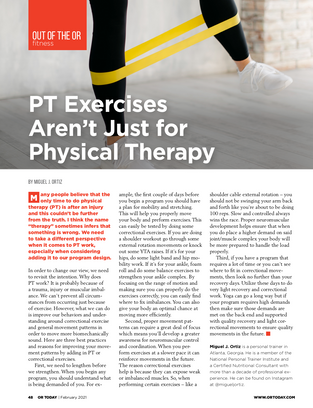PT Exercises Aren't Just For Physical Therapy : OR TODAY
- migueljortiz
- Feb 1, 2021
- 2 min read

Many people believe that the only time to do physical therapy (PT) is after an injury and this couldn’t be further from the truth. I think the name “therapy” sometimes infers that something is wrong. We need to take a different perspective when it comes to PT work, especially when considering adding it to our program design. In order to change our view, we need to revisit the intention. Why does PT work? It is probably because of a trauma, injury or muscular imbal- ance. We can’t prevent all circum- stances from occurring just because of exercise. However, what we can do is improve our behaviors and under- standing around correctional exercise and general movement patterns in order to move more biomechanically sound. Here are three best practices and reasons for improving your move- ment patterns by adding in PT or correctional exercises. First, we need to lengthen before we strengthen. When you begin any program, you should understand what is being demanded of you. For ex- ample, the first couple of days before you begin a program you should have a plan for mobility and stretching. This will help you properly move your body and preform exercises. This can easily be tested by doing some correctional exercises. If you are doing a shoulder workout go through some external rotation movements or knock out some YTA raises. If it’s for your hips, do some light band and hip mo- bility work. If it’s for your ankle, foam roll and do some balance exercises to strengthen your ankle complex. By focusing on the range of motion and making sure you can properly do the exercises correctly, you can easily find where to fix imbalances. You can also give your body an optimal chance at moving more efficiently. Second, proper movement pat- terns can require a great deal of focus which means you’ll develop a greater awareness for neuromuscular control and coordination. When you per- form exercises at a slower pace it can reinforce movements in the future. The reason correctional exercises help is because they can expose weak or imbalanced muscles. So, when performing certain exercises – like a shoulder cable external rotation – you should not be swinging your arm back and forth like you’re about to be doing 100 reps. Slow and controlled always wins the race. Proper neuromuscular development helps ensure that when you do place a higher demand on said joint/muscle complex your body will be more prepared to handle the load properly. Third, if you have a program that requires a lot of time or you can’t see where to fit in correctional move- ments, then look no further than your recovery days. Utilize these days to do very light recovery and correctional work. Yoga can go a long way but if your program requires high demands then make sure those demands are met on the back end and supported with quality recovery and light cor- rectional movements to ensure quality movements in the future.









Comments